As an Amazon Associate I earn from qualifying purchases.
If you want a blood sausage recipe that’s approachable, this is the one. It is a Portuguese blood sausage that combines pork, pork fat and pork blood into a cohesive whole. I’ll walk you through how to make it.
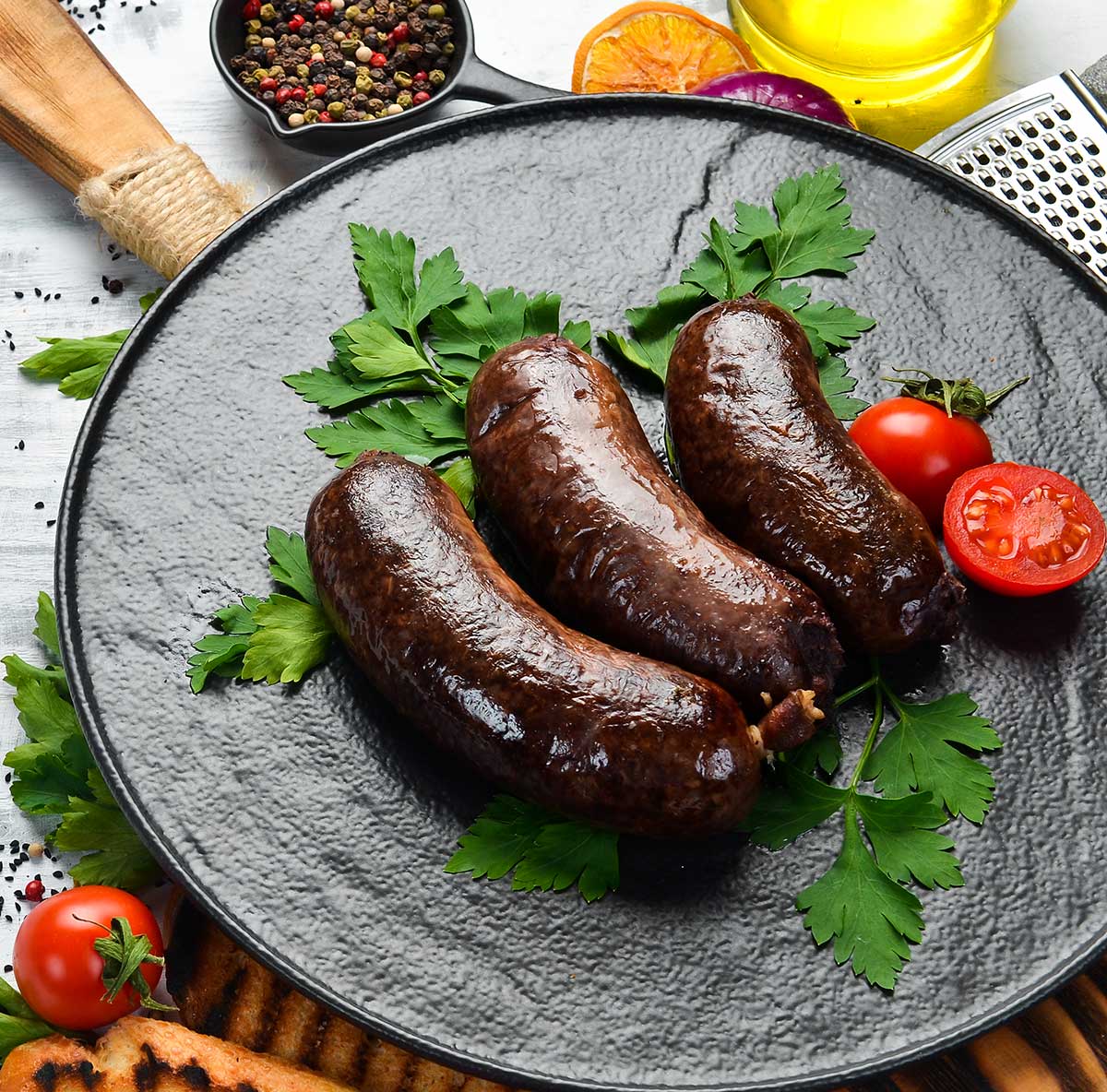
I’m from New Jersey, and much of what I learned about how to interact with others I learned from my stepfather Frank. Frank’s main rule was, “always have favors you can collect on, and don’t be afraid to do other people favors.” I do something for you, you return the favor — scratching each other’s back is a way of life. It’s how I roll.
So some years ago, when I drove down to Galt to collect a few hundred pounds of Touriga Nacional wine grapes from a Portuguese grower named Ron Silva, I wasn’t shocked when he told me not to worry about money. “No,” he said. “Instead, show me how to make blood sausage.” No problem, I said.
Blood sausage. Actually, Ron said “morcella.” I knew what he meant, although I refer to it mentally by its Spanish name morcilla. My neighbor from Argentina calls it more-SEE-zhuh, my other neighbor from Italy calls it sanguinaccio. Go to Louisiana or France and it’s boudin noir. But the first time I ate this odd delight was in South Africa, as part of a traditional English breakfast. And there it was stripped of any lyrical nicknames: The waiter called it “blood pudding.”
I know how to make blood sausage, but until I developed this recipe I had limited success. Many versions are blood and seasonings and that’s it — they are brutal to stuff into casings and were the source of failure whenever I’d been around the process in the past. Besides, to my palate, the blood-only sausages were a bit too cakey; more blood cake and less sausage. They have a weird mouthfeel.
I know. Many of you are saying to yourselves, blood. As an ingredient. In food that you’d eat. I know I glossed over it in the first few graphs of this post, but if you are still reading I thought I’d stop to tell you that first, there is quite a bit of nutrition in blood (especially iron and other minerals), and the addition of blood in a dish will make it seem fattier and richer than it really is.
(Pork blood also makes a great pasta, believe it or not!)
Pork blood will solidify and stay moist, while beef blood becomes crumbly and dry — one more reason why the pig is God’s Gift. And blood is cheap, so if you are on a budget think about it. Finally, blood is also a spectacular binder, much like egg whites. Herein lies the secret to my morcilla.
My blood sausage is bound with blood rather than a pure blood sausage. It has pork shoulder and pork fat, parsley, onions and lots of ground bay leaves.
I woke up early on a Saturday, drove down to the Davis farmer’s market and picked up some pork blood, as well as a big slab of pork shoulder. I was eager to repay Ron for the wine grapes — not because I wanted to get it over with, but because I enjoy the interplay of favors that my world once revolved around. This is a life bound more closely to other people than is that lived by those who follow the principle of “neither a borrower nor a lender be.”
I also enjoy teaching others some of the more esoteric things I’ve learned in my travels. (Thus this blog.)
Incidentally, when you want to make blood sausage yourself, you will find the blood in Asian markets, usually frozen. Or ask a local butcher to get it for you. It might take a week or so, but you can definitely buy pork blood in the United States.
When Ron and his wife Kathy arrived, I learned that Ron is a total morcella hound. “Morcella, morcella, morcella,” Kathy said. “When we were in the Azores, we’d go to Michelin-starred restaurants and he’d find the morcella.”
I think Ron was hoping I’d make more than five pounds, as he is a hearty eater. But all my recipes are about five pounds, and blood sausage is so rich non-farmers typically can’t eat too much at a sitting. But Ron was OK with it: I was teaching him to fish at the same time I was giving him some. At any rate, he watched the process intently.
Morcilla is an odd sausage to make. Instead of a solid bind that you want with a normal sausage, you pour in enough blood to make a loose slurry. It looks like the leftovers from a field hospital during the World War I.
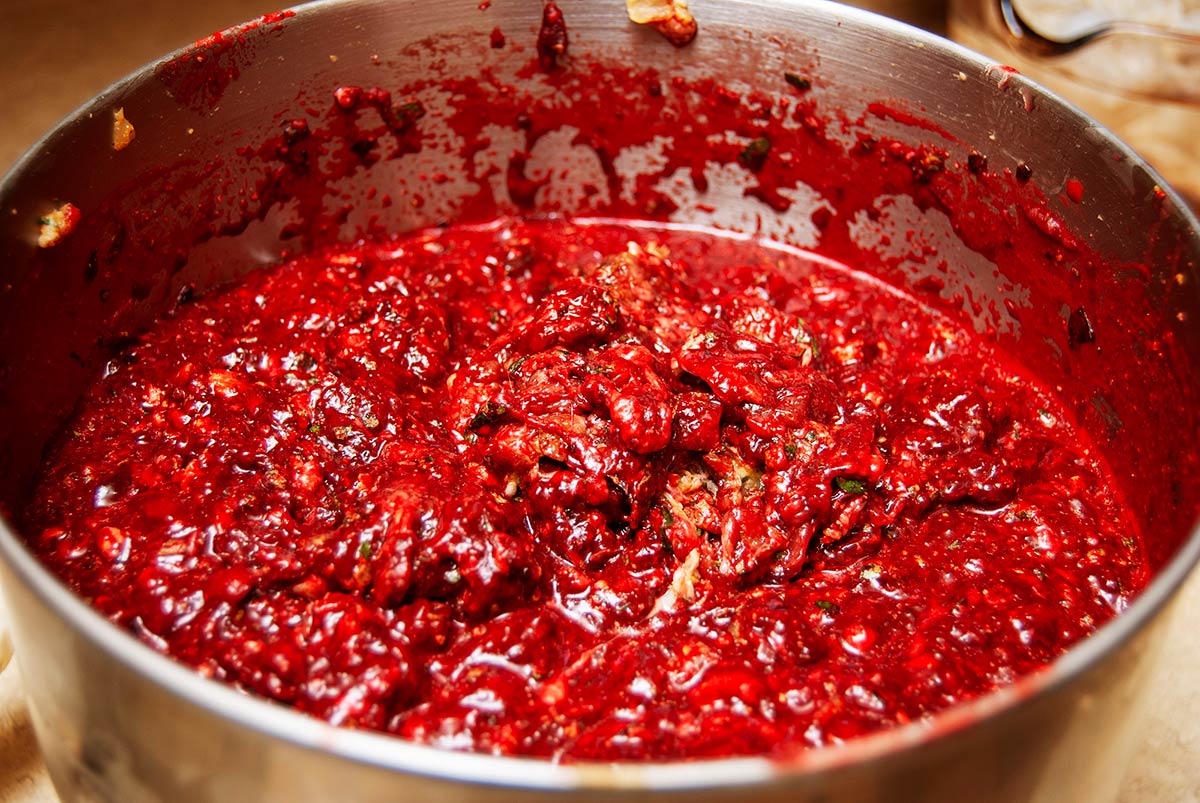
At least the slurry is solid enough that I can use a regular sausage-stuffer to form the links, although you must tie off those links with string; they are too loose to hold if you just twist them like a regular sausage.
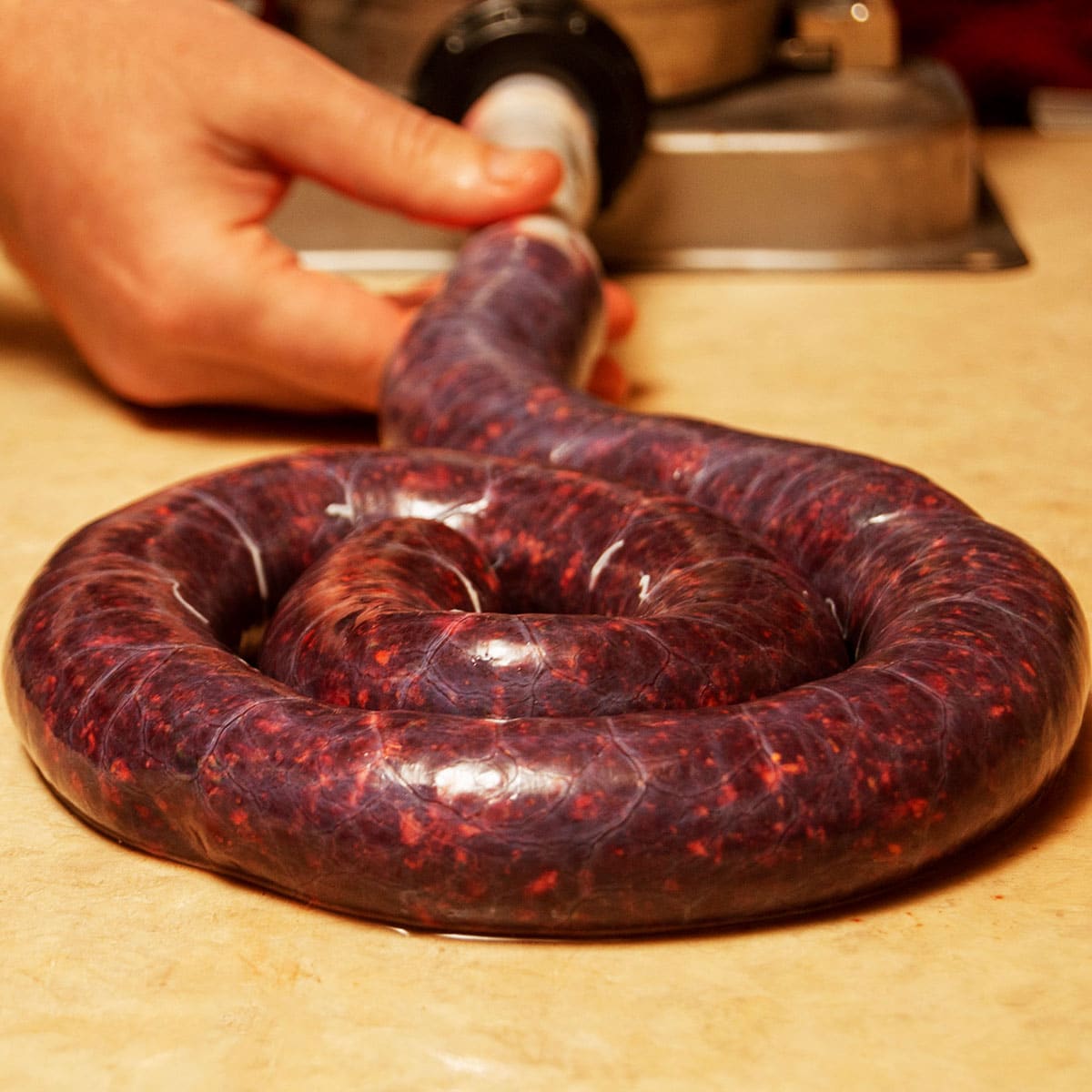
Another step you need to take is to poach the raw blood sausage in 170°F water. Not a simmer, and definitely not a boil (the blood will curdle. Ew.), but hot enough to solidify the blood to make a firm sausage.
After the poaching, you can then do what you want. I smoked mine over almond wood at 200°F for a couple hours, but you can then fry them, grill them, drop a few into a soup — whatever.
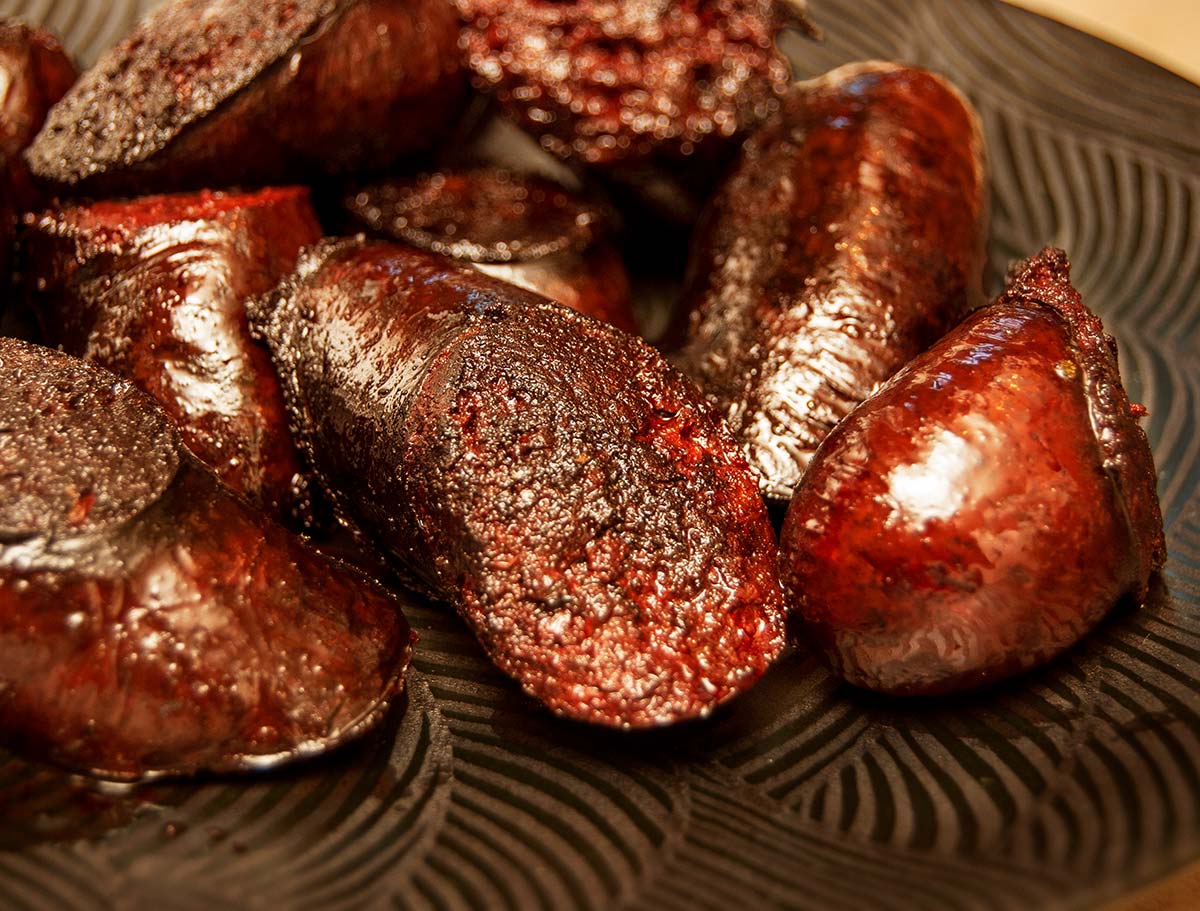
They are delicious: Softer than a regular sausage but still meaty, with a taste you can only really describe as “dark.” You know there is blood in there, but you can also pick up the pork and onions and the bay leaves. The fresh parsley brightens the whole affair enough that you don’t feel awkward eating them on a sunny day.
New to making sausage? You can find my detailed tutorial on how to make sausages at home here.
Portuguese Blood Sausage
Ingredients
- 1 quart pork blood (probably 1/2 gallon)
- 3 pounds pork shoulder
- 1/2 pound pork fat
- 2 cups chopped onions
- 1/4 cup duck fat or fresh lard
- 36 grams kosher salt, about 3 tablespoons
- 6 grams Instacure No. 1, about 1/4 teaspoon (optional)
- 10 grams freshly ground black pepper, about a tablespoon
- 6 grams ground bay leaves, about a tablespoon
- 1/2 cup minced parsley
- 3 tablespoons sweet paprika
Instructions
- Freeze the pork fat. Cook the chopped onions in the duck fat or lard over medium-low heat until they are caramelized, about 15 to 20 minutes. Remove and cool them. I do this step the day before.
- Mix both salts, and the pepper, parsley, bay leaves and paprika. Cut the pork and fat into chunks and coat everything with the spice mix.
- Chill everything: bowls, grinder parts, sausage stuffer parts, and especially the meat, fat and blood. I put everything in the freezer for a few hours. You are looking for temperatures close to freezing.
- Take the hog casings out and put what you need in a bowl of warm water. Depending on their width, you’ll need 10 to 20 feet worth. Many places sell casings specifically to make 5-pound batches. Be sure to drape the end of each casing over the side of the bowl so you can find it later.
- Using the coarse die (6.5 mm), grind the meat and fat. If you wish, you can run everything a second time through a fine die. I don't. Make sure the meat and fat are at no warmer than 35°F when you grind. Put the meat and fat into the freezer and clean up.
- Fill the largest pot you own with water and heat it to steaming, but not boiling. Ideally you want something like 170°F.
- Meanwhile, attach the paddle to your KitchenAid or other mixer, or, alternately, get a stout wooden spoon. Take the meat and fat mixture out and add the cooked onions. Pour in about a pint of blood. Stir on Level 1 on the mixer or with the wooden spoon. Add some more blood as you go; it’s not an exact science. You want a loose slurry that is quasi-emulsified — a consistency like pancake batter. When it is the consistency you want, put the mix back in the fridge and clean up. Get your sausage-stuffer ready and thread a hog casing onto it.
- Pour the mix into the sausage stuffer and begin making your sausages. Make the whole coil before you tie them into links. This is a little tricky, and it helps to have a second person help. You need to tie off blood sausage with twine because it is very loose inside and twisted links will fall out. Repeat until you are done with all the sausage. Get the largest bowl you own and fill it 2/3 of the way up with ice and water.
- If you have some wooden dowels, use them to gently lower the sausages into the pot of hot water. Do one at a time. Let the sausages poach for 15 minutes and then place them in the ice water. When the sausages are cool, remove them gently and hang them to dry out for an hour or so. You can now smoke them, or cook in any way you’d like.
Notes
Nutrition
Nutrition information is automatically calculated, so should only be used as an approximation.

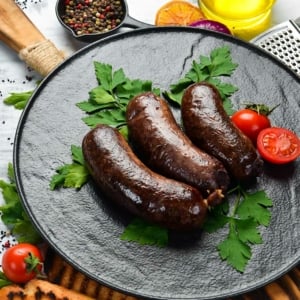

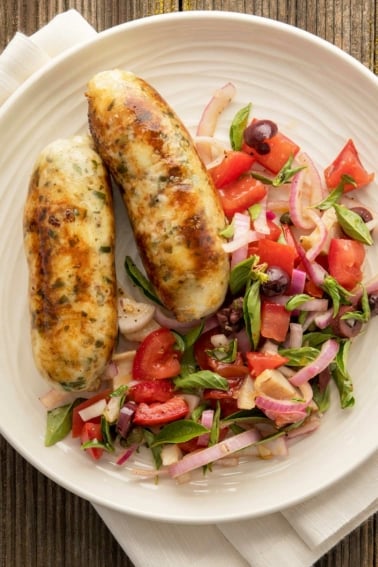
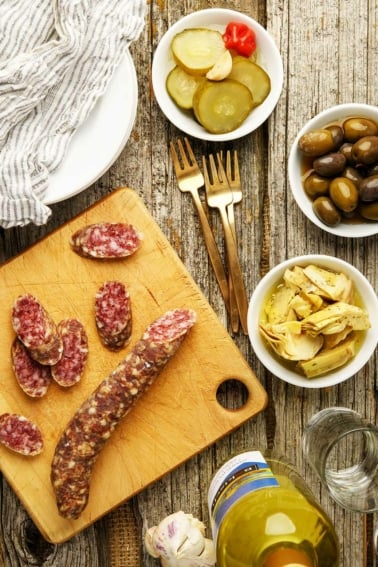

Nice post. My mom used to make this for my dad but she called it blood pudding. Great to have a recipe.
Thanks again
ATB!
Perry
I ve been cooking for about 55 years and was brought up by my grandmother who went through the wars , famine and rationing , she taught me a lot about food , everyone needs it so think about a job doing it and getting paid for it . Everything that walks, swims, flies and crawls is edible , with vegetables to help it along on the side. The only thing I can’t eat is Tripe and onions , ( the lining to a cows stomach ) the texture just puts me off , I was taught how to make Sausage , black or white pudding and various other things to eat to keep you alive . She lived to 95 years old still cooking her own food and drinking alcohol , smoking and enjoying everyday of her life , it was only when she went to hospital for a broken hip they took all her pleasures away , her answer to them cannot be repeated here , she died 9 days after going in having a huge whiskey and a cigarette laying down said “Thats it I m off ” she never woke up but the things she taught me about food would make all these celebrity chefs shudder , no messing about just get in there , the only one I think is near my Grandmother is Gordon Ramsey …. Enjoy everything that is put in front of you , never say you don’t like it if you have nt tried it and shut your eyes if you think it’s going to be bad but you will enjoy it ….
I grew up on blood sausage, potato sausage, head cheese, pickled tongue and heart and so many other oddities. We had a farm and butchered both pigs and beef. I was taught how to catch the pig’s blood and keep stirring it so it would not coagulate. It is nice to hear about others who like the same foods. We had our own sausage stuffer and used pig casings to stuff the sausage into. Everything that you said sounded so familiar to me. We would generally eat our blood sausage with syrup.
Hey, this really works; I had whole lot of blood left over from a half pig bought from a local farm, and was going to chuck it when I happened to chance upon this recipe. I had all the other ingredients in my store, so I thought “let’s have a go”. Brilliant!!
We just finished making this and it’s wonderful!!
Since we didn’t have pig blood, we used beef blood someone gifted us. The pork, onion, parsley & bay are homegrown, and we smoked the links over a mostly applewood fire. It was our first time making sausage, and I can’t wait to try more using all the pig & cow parts we have in the freezer.
So, my father immigrated from the Basque Country and every year he would go out with his friends kill a couple of pigs and bring home morcilla as well as jamón serrano, tocino, jeta…. anyways, he passed away and he never taught me how to make it. Every now and then I stumble across a restaurant the offers morcilla (Spanish or Basque) but I am unable to find it anywhere. I know where to get black pudding, but it’s not quite the same. Do you know where I could buy morcilla? Or cured morcilla from Burgos? Any guidance would be soooooo appreciated. Taylor’s in Oakland said that if I gave them a recipe they would make me a batch just for me… I may just give them your recipe, but would rather get it from a place that is familiar with making morcilla.
Thank you for this!
Blood sausage is the food of the gods! I’ve been eating it ever since it was introduced to me by my grandfather at age 5 or so. Here in the UK, it is known as ‘Black Pudding’ and interestingly, the word ‘pudding’ is exactly the same as the French word, ‘Boudin’ from the French variety Boudin Noir (say it quickly with a French accent, you and you immediately notice the similarity). Most European countries have a blood pudding and they vary in the fillers and spicing that they use, but they are always a treat. In the Carribean, there are spicier versions (not to my taste, I must add). Blood sausage goes well with so many things, but my favourites are on the breakfast plate, as a Tapas fried together with a sweet desert apple, or another classic combination, with seafood, notably scallops.
I’ve had blood sausage only once, and it probably wasn’t as good as yours because the inside was a bit crumbly (not well-bound at all)!
I reflect on my experience with it: https://kitchenlife.wordpress.com/2008/11/23/blood-sausage/
Love black pudding, have been savoring it for most of the 55 years on the planet. I get mine from a local Irish Import shop in the Rochester NY area that has a freezer full of bangers, white pudding, Irish bacon. It’s a delight.
I ate some in Madrid, Spain and found it to be quite agreeable and I am sure it is very nutritious – you don’t need to eat it only at midnight on a full moon.
Hurray for black pudding!
Ever since I traveled through Spain as a teen on a budget, I’ve sought the deliciously rich goodness blood sausage. I am excited to read your recipe and description, as I have been researching the ins and outs of making some my self.
I have eaten a few different blood sausages made by local producers like the Fatted Calf and your friends at Boccalone. However having my own source for blood I regularly dream of making my own. I am particularly excited by Mary’s comment about using stomach because I have been unable to keep any of our casings, but I do have a few stomachs.
MMM bring on the black hog maw!
I love Boudin Noir, but I don’t see it for sale too much around here. Last time I ate in was in France, when visiting family. Typically it’s fried and serve with parsley potatoes and a big green salad.
Thank you for posting what you do. Now I just need to source some fresh blood from a hog raised not in an industrial fashion!
Dear Hank,
I’ve followed your blog for a while now–it’s excellent and quite different than many of the other food blogs out there. (I’d characterize your blog as not only a food blog but as a lifestyle, philosophy, and do-it-yourself blog.)
Perhaps it’s because I’m Asian, but the notion of eating blood doesn’t make me squeamish. One of my favorite Korean soups, hae jong guk (translated loosely to “hangover solution soup” and pronounced “hay jung gook”) is made from beef bones, greens, bean sprouts, and, occasionally, beef blood. Medium-sized cubes of boiled beef blood which, like you said, becomes crumbly and dry–thus leading me to break the cubes up into my broth.
Koreans also have blood sausage called soondae, which contains pork blood and, importantly, cellophane or glass noodles. These are mixed with spices and stuffed into pigs’ intestines, then usually steamed and eaten sliced–often alongside sliced liver, tongue, and pork ear and washed down with beer or soju. There’s also soondaeguk, a hearty stew whose main ingredient is sliced soondae. Delicious.
Thank you for your interesting–and different–posts!
Joon S.
https://vinicultured.com
this is one of our favorite things to eat. i applaud you for making morcilla. we feature morcilla on our blog often. a few of our favorite ways to eat it have been:
https://www.weareneverfull.com/morcilla-stuffed-squid-bloody-hell/
https://www.weareneverfull.com/viva-el-patacon-and-childish-humor/
and
https://www.weareneverfull.com/stuff-this-into-your-easter-basket-hornazo-spanish-easter-bread/
Honestly never tried them, but would like to someday. I’m intrigued by your crimson slurry.
Also, your pictures for this are phenomenal.
W-O-W! Now that’s what I call a dream! I’m going to have to agree with Ron, Hank. 5 pounds just isn’t enough! 🙂
The pictures are just awesome, too.
I don’t look for blood sausages in places like Tokyo where they’re difficult to find – but they’re all over the place in Spain and I’ve had some really delicious ones and some not so great tasting ones. Yes – they’re called Morcilla here and they’re an important ingredient when making Fabada. I’ve also made other bean stews with them. They can really enrich the ‘taste’ of whatever beans you’re cooking and also make great tapas fried in extra virgin olive oil or with some types, you can just eat them as they are (like Salami).
Josh
The food interests have stayed even if I haven’t seen the girls in question in decades, Shelia was 1970 in London, Regina, she of sushi note, about 6-7 years later in NYC.
I met my wife over 29 years ago and haven’t done more than window shopping since. She offered me brains, and while I was interested in trying them and liked the taste, I literally could not swallow them. My four year old had no trouble with them, of course we didn’t mention what they were.
Mmm, blood sausage. I tasted boudin noir for the first time while studying abroad in France. I loved it so much, I sought out both the German equivalent and the Spanish equivalent when I went travelling on spring break.
A lesson on blood sausage sounds like a lovely favor to be owed. 🙂